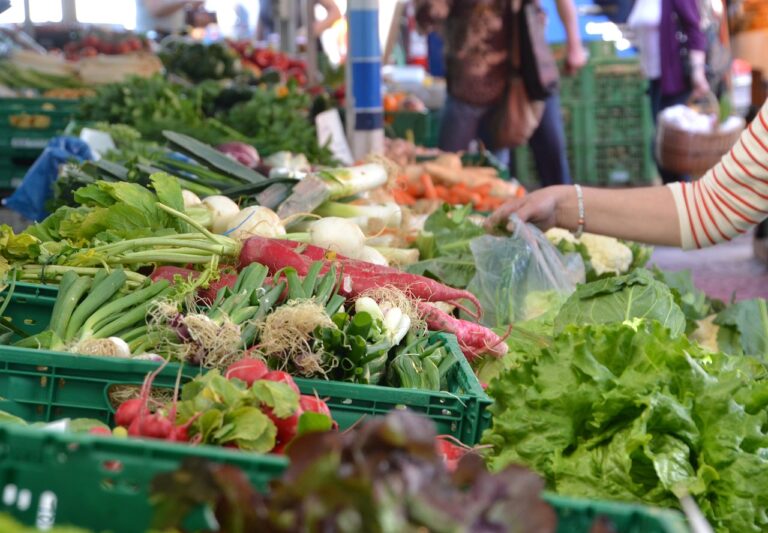Why engaging with food insecurity in the context of climate change is increasingly important

On this World Food Day, which marks the 80th anniversary of the founding of United Nations Food and Agriculture Organization, former master’s students of the Climate Food (In)security Lab at the Grantham Research Institute explain how food security is defined and highlight how climate change is already worsening our food and nutritional security.
What is food security?
The 1996 World Food Summit defined food security as being when “all people, at all times, have physical and economic access to sufficient, safe and nutritious food that meets their dietary needs and food preferences for an active and healthy life”. As such, food security requires food to be available, affordable, culturally appropriate and nutritious.
The Office of the United Nations High Commissioner for Human Rights stipulates that the right to food is enshrined in international law providing an entitlement to access all requisite resources for the enjoyment of food security.
In 2015, the world committed to ending malnutrition and achieving global food security by 2030, with food security and improved nutrition represented in Goal 2, ‘Zero Hunger’, of the United Nations Sustainable Development Goals. Yet soon after that date, the prevalence of undernourishment, which had been on a downward trend, began to increase, and only recently has it started to decline again.
Generally, four pillars of food security are considered: availability, access, utilisation and stability.
Food availability is the physical presence of food in a region and so is closely linked to crop and livestock production and food stocks, in addition to trade. Sometimes food production is conflated with food security, or used as a proxy for food security. But high levels of production can be found alongside high levels of food insecurity as a result of poverty, inequalities, distribution and conflicts, among other factors.
Food access refers to individuals’ and countries’ ability to obtain sufficient quantities and qualities of food, and so depends on various factors such as food prices, market accessibility, income and wealth distribution.
Food utilisation relates to the process by which a body uses the food it consumes to meet its nutritional needs and can be affected by people’s ability to prepare food under hygienic conditions; the presence of food-borne mycotoxins; and the extent to which a person’s body is able to absorb and use nutrients from food. Undernutrition, often considered separately from food insecurity, can be driven not only by a lack of access to sufficient and nutritious food, but is closely linked to utilisation, including whether someone is suffering from diarrhoeal diseases or intestinal parasites, for example, which affect nutrient utilisation.
Food stability is a cross-cutting concept and refers to food being available and people being able to access it consistently and reliably over time. A lack of stability could be driven by conflicts, seasonal food shortages, or acute climate-linked events such as droughts.
Climate change is already affecting food security
Engaging with food insecurity in a climate insecure world is increasingly important. Both observed and projected future climate change are predicted with high confidence to affect all four pillars of food security. We explain some of the links between climate change and food and nutritional security below.
Availability
Climate and weather shocks are already negatively affecting global food production, and these impacts are projected to worsen with future climate change. For example, climate change is already having an adverse effect on crop yields, including millet yields in West Africa. Increasing temperatures and increasing frequency of droughts, heatwaves and extreme precipitation events can affect harvests and increase price volatility, increase long-term soil degradation, and worsen water scarcity and soil erosion. Crop yields are also being affected by climate change-induced increases in the prevalence of agricultural pests and diseases. For example, tropical cyclones in East Africa, which are becoming more extreme due to climate change, provide the warm, sandy and wet soil that is an ideal environment for locust outbreaks. While most of these impacts are negative, there are a few short-term effects that appear beneficial.
For example, increased CO2 levels resulting from climatic change have also long been recognised to be increasing crop yields for many of the major grains. Elevated CO2 appears to have a strong and positive impact on cassava yields, which, coupled with cassava’s drought-tolerance, makes it a climate-smart crop. This is important for sub-Saharan Africa, where the positive CO2 fertilisation effect is more likely to be outweighed by the negative heat and drought effects of climate change. Also in sub-Saharan Africa, sorghum appears, at least in the short term, to be benefiting from the overall impacts of climate change.
However, higher levels of CO2 negatively affect the macro and micro nutritional quality of certain grains, which has a negative impact on grain protein quality and critical nutrients such as amino acids. And despite the benefits of CO2 fertilisation for some crops, in the main, climate change is harming the availability of food.
Access
Increasingly, incidences of heatwaves, gradual increases in temperature and drought are having a negative impact on food access. For every 1°C of temperature anomaly, measured by the difference between the mean annual temperature and the 30-year mean temperature for each region, global food insecurity was estimated to have increased by 1.4% in 2014 and 1.64% in 2019. In Malawi, a 1°C increase in temperature was found to have reduced food consumption by approximately 18% and daily calorie intake by 20% between 2010 and 2017. Food prices in flood-affected communities in Bangladesh have been found to be higher than in communities not affected by flooding, with the effects lasting for up to nine months after a flood event.
Utilisation
Climate change affects the food utilisation pillar by reducing food safety and impairing the body’s ability to absorb nutrients through increased mycotoxins, increased prevalence of water and food-borne diseases, and reducing the nutritional value of staple crops such as wheat, rice and maize. In Peru, the El Nino weather pattern increased the number of hospital admissions for diarrhoea by 200% above numbers expected during regular seasonal ambient temperatures. And in the US, the increasing frequency of heavy rainfall events has increased the occurrence of waterborne disease outbreaks. Higher temperatures are associated with greater prevalence of diarrhoeal diseases, which hinder nutrient absorption and are a leading cause of malnutrition. Rising sea levels also increase soil salinity, contributing to excess sodium in diets.
Stability
In the wider agrifood chain, climate and weather shocks, which are increasingly frequent and intense due to climate change, affect processing, transportation and markets. Extreme weather shocks that disrupt transportation routes can result in localised shortages and market segmentation, driving input and consumer price volatility which affects people’s ability to access and afford healthy and nutritious food.
Evidence clearly shows that climate change is undermining all four pillars of food security, and the food system more broadly. The combined negative impacts of warming, extreme weather events, and declining nutritional quality require integrated policy responses that strengthen the resilience of agri-food systems Such actions could involve improved early warning systems, financial and technological support for farmers, and safety nets. Sustained commitment to these priorities is essential if progress towards Zero Hunger is to be achieved in an increasingly climate-insecure world.
The commentary represents work by former LSE master’s students Lucia Letsch, Lauren O’Leary, Charlotte Panhuyzen, and Deyan Pehlivanov, whose LSE MSc dissertations addressed different aspects of food security. Elizabeth Robinson, Shouro Dasgupta and Alice Bian also contributed.

